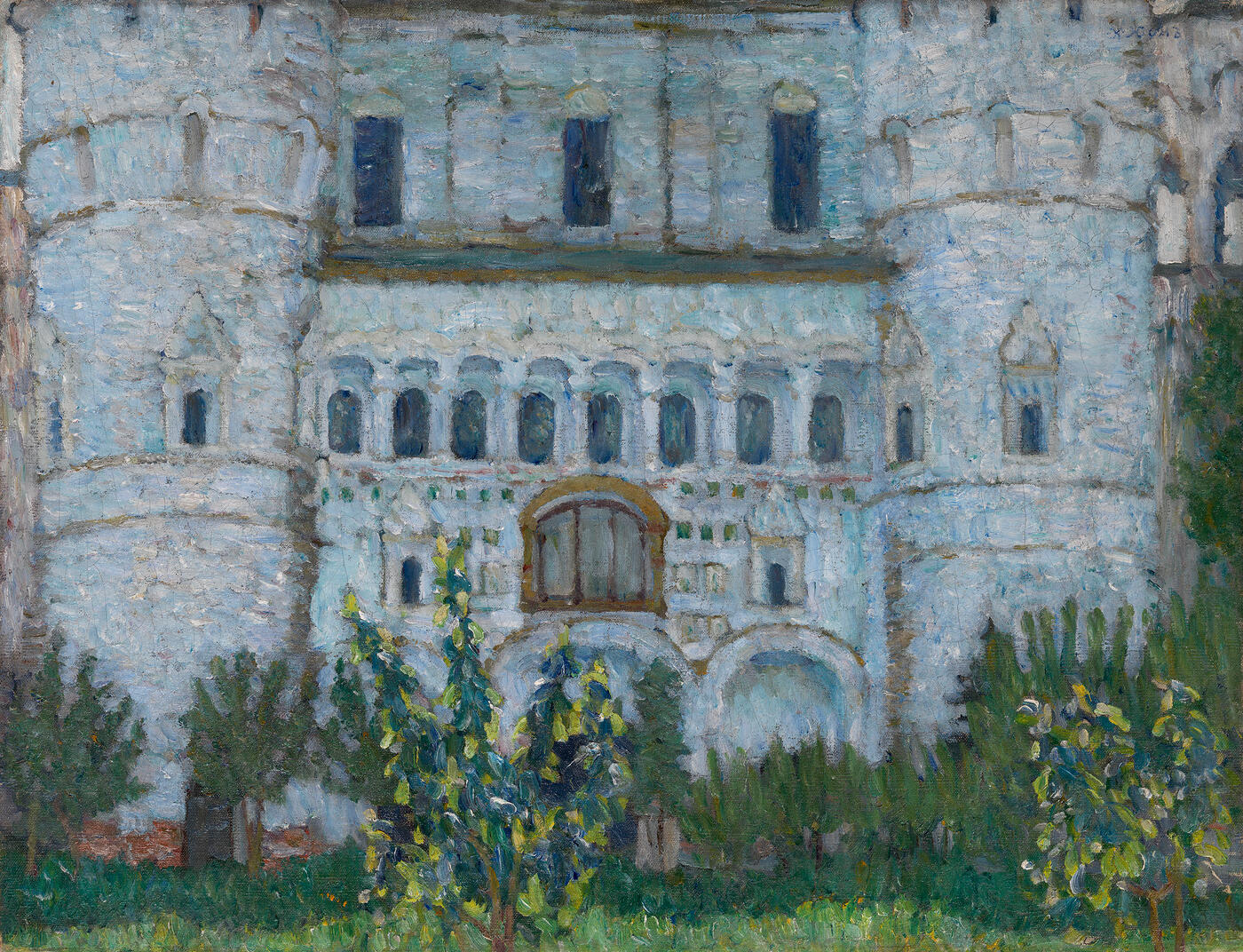MacDougall's Russian Art Auctions 27-30 May 2012
27 May 2012

* 2. YUON, KONSTANTIN (1875-1958)
Gates of the Rostov Kremlin, signed.
Oil on canvas, 63 by 81 cm.
220,000–400,000 GBP
Provenance: Previously in the collection of I. Isadzhanov, Moscow.
Private collection, Europe.
Authenticity of the work has been confirmed by the expert Yu. Rybakova.
Exhibited: Vystavka kartin K.F. Yuona. K 25-letiyu khudozhestvennoi deyatel’nosti, The State Tretyakov Gallery, Moscow, 1926, No. 7.
Sovetskie khudozhniki starshego pokoleniya, Moscow, June 1958 (label on the reverse).
Literature: A. Koiransky, K.F. Yuon, St Petersburg, A. Kogan, 1918, p. 68, listed under works from 1906.
Exhibition catalogue, Vystavka kartin K.F. Yuona. K 25-letiyu khudozhestvennoi deyatel’nosti, Moscow, 1926, p. 30, No. 7, listed.
N. Tretyakov, K.F. Yuon, Moscow, 1957, p. 103, listed under works from 1906.
Yu. Osmolovskii, Konstantin Fedorovich Yuon, Moscow, Sovetskii khudozhnik, 1982, p. 226, listed under works from 1906.
The present work was published as a postcard by the Community of Saint Eugenia before 1926.
Konstantin Yuon’s cycle of works dedicated to the ancient Russian town of Rostov the Great dates back to 1903, when a
record in his handwriting appeared in the visitors’ book of the Rostov Museum: “Konstantin Yuon, artist from Moscow”. From that time on Rostov was for many years a place of pilgrimage for the artist. He came to work here from 1904 to 1906 and again from 1913 to 1916. The majestic ancient architecture became the subject of many of Yuon’s Rostov paintings. The majority of these works are now held in the State Tretyakov Gallery and the State Russian Museum as well as local museums in Omsk, Ryazan and Serpukhov.
One of the few exceptions is the outstanding Gates of the Rostov Kremlin, well known from books, which has hitherto remained in a private collection but which MacDougall’s now offers for the first time at public auction. It is one of the most important works in the Rostov cycle. Painted in 1906, it differs dramatically from Yuon’s other works of this period which are based on the interaction between a genre element in the foreground and a wide panorama of the kremlin (Fine Day. Rostov the Great, 1906; Spring Evening. Rostov the Great, 1906; Winter. Rostov the Great, 1906).
Painted from life, Gates of the Rostov Kremlin astounds the viewer with the sheer strength of its architectural mass. The artist is seeking to convey the powerful resonance of the white stone of the main holy gates of the kremlin, the harmoniously
aligned rhythms of the two fortress towers adjoining the gates and the gatehouse church of the Resurrection, the window apertures of which in their rhythmic tread echo the arcades of the gallery. This striking effect is strengthened by the minimalism of the details, carefully selected and positioned, providing colour accents in the monochrome mass of stone. This piece clearly indicates the influence of Serov with his delicate nuances in composition and lighting.
Yuon depicts a bright summer’s day but does not drench the scene in light, instead he makes his sunlit world, and first and foremost the architecture, extremely clear and well-defined in terms of its mass, while at the same time conveying the tremulousness and transparency of the summer atmosphere. The variety of the colour and light effects, the air and sunshine which pervade the picture, the purity of the paints, the colour in the shadows, the lively texture of his free brushwork – all these superlative aspects of Yuon’s technique are present in Gates of the Rostov Kremlin.
Thanks to the authentically Impressionistic treatment of the motif, in Yuon’s characterisitc generalisation of forms, the fragmented
composition and the broad brush-strokes, this canvas becomes a true paean to light, the nation’s history seemingly come to life before our eyes. The artist explained his Rostov works thus: “At that time it was as if I were painting and living in two different eras – encompassing both the past and the present.”
Notes on symbols:
* Indicates 5% Import Duty Charge applies.
Ω Indicates 20% Import Duty Charge applies.
§ Indicates Artist's Resale Right applies.
† Indicates Standard VAT scheme applies, and the rate of 20% VAT will be charged on both hammer price and premium.